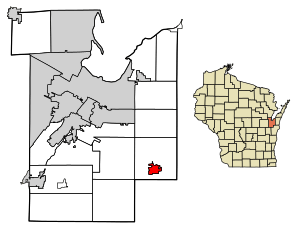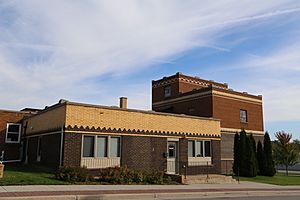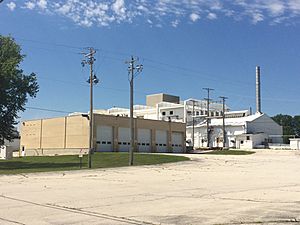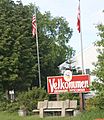Denmark, Wisconsin facts for kids
Quick facts for kids
Denmark, Wisconsin
|
|
|---|---|
|
Village
|
|

Downtown Denmark
|
|

Location of Denmark in Brown County, Wisconsin.
|
|
| Country | |
| State | |
| County | Brown |
| Area | |
| • Total | 1.97 sq mi (5.10 km2) |
| • Land | 1.97 sq mi (5.10 km2) |
| • Water | 0.00 sq mi (0.00 km2) |
| Elevation | 873 ft (266 m) |
| Population
(2020)
|
|
| • Total | 2,408 |
| • Density | 1,155.84/sq mi (446.25/km2) |
| Time zone | UTC−06:00 (Central (CST)) |
| • Summer (DST) | UTC−05:00 (CDT) |
| ZIP Code |
54208
|
| Area code(s) | 920 |
| FIPS code | 55-19700 |
| GNIS feature ID | 1563900 |
| Website | www.denmark-wi.org |
Denmark is a small village in Brown County, located in the state of Wisconsin in the United States. In 2020, about 2,408 people lived there. It is part of the larger Green Bay area. The village of Denmark is actually located within the town of New Denmark.
Danish immigrants started settling in Denmark around 1848. This area became a very important place for Danish people moving to the United States.
Contents
The Story of Denmark
How Denmark Started
In 1846, a person from Prussia named John Bartlme bought 40 acres of land in the area where Denmark is now.
Two years later, in 1848, the first Danish immigrant arrived. His name was Niels Gotfredsen. He bought 160 acres of land. People called him and his wife the 'King and Queen of Denmark' because they were the first Danish settlers in the area.
A Big Decision in 1854
In 1854, people in Brown County, Wisconsin had to vote. They needed to decide if Green Bay or De Pere would be the main city for the county. At the same time, the people of Denmark wanted to build a church but didn't have money.
A person from De Pere came to Denmark and offered money. They said they would pay two dollars for every vote Denmark residents cast for De Pere. On election day, 15 men and boys from Denmark voted for De Pere. The town received $30. Instead of building a church, they used the money to build a school.
Denmark's First Store
In 1871, Hans Beyer moved from old Denmark to New York City. From there, he traveled to Green Bay. It took him seven hours by ox team to reach Denmark. In 1875, Beyer opened the first business in Denmark, a store. He used a loan of $200 to start it. In 1896, he built a new store and a cheese factory next to his old one.
Denmark Grows Up
In 1906, the Chicago & Northwestern railroad built tracks through the village. The train station was in the downtown area. The railroad was first planned to go through Cooperstown, Wisconsin, but officials changed their minds.
On June 15, 1915, the people of Denmark held a special vote. They decided if their town should officially become a village. The vote was 109 in favor and 26 against. Later that year, Denmark officially became a village.
Also in 1915, the Kriwanek Brothers opened a Ford car dealership. It was the second oldest Ford dealership in all of Wisconsin.
On March 3, 1949, the Denmark State Bank was robbed. This was the first bank robbery in Brown County, Wisconsin. The Federal Bureau of Investigation (FBI) helped, and the people responsible were caught.
Recent History
The last passenger train came through Denmark on April 30, 1971. In 1981, a big highway called Interstate 43 opened just west of the village.
On September 7, 1988, a Chicago & Northwestern train had an accident. It derailed near a cheese plant. Twenty of the 144 train cars went off the tracks. Some cars carried chemicals like sulfuric acid and fuel oil. Other cars had chlorine, but the engineer didn't know which ones. The wind was blowing towards homes. Because of this, many people in the village had to leave their homes for safety. Luckily, no chemicals leaked, and everyone could return home.
In 1996, the train line was bought by Wisconsin Central Ltd.. They stopped using the tracks between Denmark and Rockwood, Wisconsin. These old tracks were later turned into a walking and biking path called the Devil's River State Trail. It was finished in 2013.
Denmark's Location and Weather
Denmark is located at 44°20′54″N 87°49′47″W / 44.34833°N 87.82972°W. It covers about 1.93 square miles (5.0 square kilometers) of land.
The village has a climate with four distinct seasons, called a humid continental climate. Being close to Lake Michigan helps make the weather a little milder.
| Climate data for Denmark, Wisconsin, 1981-2010 | |||||||||||||
|---|---|---|---|---|---|---|---|---|---|---|---|---|---|
| Month | Jan | Feb | Mar | Apr | May | Jun | Jul | Aug | Sep | Oct | Nov | Dec | Year |
| Mean daily maximum °F (°C) | 25 (−4) |
29.2 (−1.6) |
39 (4) |
53.1 (11.7) |
64.9 (18.3) |
75 (24) |
79.1 (26.2) |
77.9 (25.5) |
70 (21) |
56.8 (13.8) |
42.7 (5.9) |
29.4 (−1.4) |
53.5 (12.0) |
| Daily mean °F (°C) | 16.8 (−8.4) |
20.7 (−6.3) |
30.4 (−0.9) |
43.6 (6.4) |
54.6 (12.6) |
64.4 (18.0) |
69.1 (20.6) |
67.6 (19.8) |
59.6 (15.3) |
47.6 (8.7) |
35 (2) |
21.9 (−5.6) |
44.3 (6.9) |
| Mean daily minimum °F (°C) | 8.6 (−13.0) |
12.1 (−11.1) |
21.7 (−5.7) |
34 (1) |
44.3 (6.8) |
53.7 (12.1) |
59.1 (15.1) |
57.3 (14.1) |
49.1 (9.5) |
38.4 (3.6) |
27.3 (−2.6) |
14.4 (−9.8) |
35.0 (1.7) |
| Average precipitation inches (mm) | 1.40 (36) |
1.11 (28) |
1.85 (47) |
2.82 (72) |
3.13 (80) |
3.72 (94) |
3.31 (84) |
3.82 (97) |
3.52 (89) |
2.87 (73) |
2.19 (56) |
1.53 (39) |
31.27 (795) |
| Source: NOAA | |||||||||||||
Getting Around Denmark
Roads
 Interstate 43 goes north to Green Bay and south to Manitowoc, Wisconsin and Milwaukee, Wisconsin.
Interstate 43 goes north to Green Bay and south to Manitowoc, Wisconsin and Milwaukee, Wisconsin. WIS 96 starts on the west side of Denmark and goes west to Fremont, Wisconsin.
WIS 96 starts on the west side of Denmark and goes west to Fremont, Wisconsin. This road also starts on the west side of Denmark and goes east. It ends near Stangelville, Wisconsin.
This road also starts on the west side of Denmark and goes east. It ends near Stangelville, Wisconsin. This road goes through the village. It travels north to New Franken, Wisconsin and south to Maribel, WI and Kellnersville, WI.
This road goes through the village. It travels north to New Franken, Wisconsin and south to Maribel, WI and Kellnersville, WI.
Trains
The Canadian National Railway provides freight train service between Green Bay and Denmark.
Village Services
Wisconsin Public Service supplies electricity to the village. Denmark also has its own sewer and water services for residents. The village runs the Denmark Wastewater Treatment Plant, which was built in 1980.
People of Denmark
| Historical population | |||
|---|---|---|---|
| Census | Pop. | %± | |
| 1920 | 735 | — | |
| 1930 | 779 | 6.0% | |
| 1940 | 864 | 10.9% | |
| 1950 | 1,012 | 17.1% | |
| 1960 | 1,106 | 9.3% | |
| 1970 | 1,364 | 23.3% | |
| 1980 | 1,475 | 8.1% | |
| 1990 | 1,612 | 9.3% | |
| 2000 | 1,958 | 21.5% | |
| 2010 | 2,123 | 8.4% | |
| 2020 | 2,408 | 13.4% | |
| U.S. Decennial Census | |||
2010 Population Data
In 2010, there were 2,123 people living in Denmark. There were 923 households and 562 families. The village had about 1,100 people per square mile.
Most people in Denmark were White (95.3%). A small number were African American (0.4%), Native American (0.6%), or Asian (0.7%). Some people were from other races (1.6%) or from two or more races (1.4%). About 2.4% of the population was Hispanic or Latino.
About 31.9% of households had children under 18. Many households (44.7%) were married couples. About 13.6% of households had someone living alone who was 65 or older. The average household had 2.30 people.
The average age in the village was 37 years old. About 25.5% of residents were under 18. And 13.3% were 65 or older. The population was almost evenly split, with 49.0% male and 51.0% female.
Schools in Denmark
The School District of Denmark serves the village. It includes several schools:
- Early Childhood Center (for ages 4k-5k)
- Denmark Elementary School (Grades 1-5)
- Denmark Middle School (Grades 6-8)
- Denmark High School (Grades 9-12)
- Denmark Community School (Grades 8-12)
All Saints Catholic School is also in the village. It teaches students from 4k through 8th grade.
What Denmark Makes and Does
Local Businesses
Brewing Beer
In 1934, Raymond and Peter Stark started the Denmark Brewing Company. They made about 15,000 barrels of beer each year. Their beers were called 20th Century Pale and Old Town Lager. The brewery closed in 1947.
Making Cheese
In 1896, Hans Beyer built the first cheese factory in the village. It had two workers and processed a lot of milk each day. In 1899, Beyer sold the factory and his store because he was not well.
In 1912, the Danish Prize Milk Company began. Later, in 1949, the plant was bought by Lake to Lake Dairy Cooperative. They started making cheddar cheese. Under their ownership, the Denmark cheese plant became the second largest cheddar cheese maker in Wisconsin. In 1982, Lake to Lake joined with Land O' Lakes. In 2014, Land O' Lakes closed the Denmark cheese plant.
Main Employers
Some of the biggest employers in Denmark include:
- Denmark Bancshares
- Dufeck Wood Products
- Northern Concrete Construction
- Salm Partners, LLC
- United Cooperative
Fun Things to Do in Denmark
The Academy of Fine Art is located in Denmark. It's in a renovated old feed mill. This art school has eight teachers who offer art classes all year. The Academy of Fine Art is the only art school in Wisconsin certified by the Art Renewal Center.
The Denmark Historical Museum is downtown. It's in the basement of the BMO Harris Bank building.
Every summer, the Denmark Lions Club hosts a festival called the Denmark Lions Weekend. This festival lasts for three days. It often includes a demolition derby, tractor and horse pulls, live bands, a 5k run, and a parade.
Denmark News and Radio
Newspaper
Denmark has its own newspaper, The Denmark News. It is published once a week on Fridays.
Radio Stations
- WGBW 1590 AM
- WPCK 99.5 & 104.9 FM
Places to Visit
- Devil's River State Trail
Famous People from Denmark
- Theodore Marcus Hansen: A Lutheran Minister and college president.
- Erica Deichmann Gregg: A Canadian potter.
- Danen Kane: A Christian musician.
- Harvey Larsen: A Wisconsin State Representative.
- Niels P. Larsen: A Wisconsin State Representative.
- Red Ostergard: A Major League Baseball player for the Chicago White Sox.
- Johan Olsen: A pastor and church leader.
- Jean Sutton: A science fiction author.
- Paul J. Tikalsky: An engineer and dean at Oklahoma State University.
Images for kids
-
Velkommen sign showing relationship with the country of Denmark
See also
 In Spanish: Denmark (Wisconsin) para niños
In Spanish: Denmark (Wisconsin) para niños















